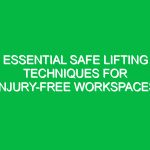Welcome Team!
Today, we gather for our Toolbox Talk to discuss an essential topic that impacts each one of us in our daily operations: The “WHY” for “WHAT” Needs Done within the Health, Safety, and Environment (HSE) domain. Understanding this concept is crucial not only for compliance but also for fostering a culture of Safety and awareness in our workplace.
The Importance of Understanding the “WHY”
Before we dive into specifics, let’s clarify what we mean by The “WHY” for “WHAT” Needs Done. It refers to understanding the reasons behind the Procedures and practices we implement in our work environment. When we grasp the “why,” we become more committed to adhering to Safety protocols and procedures. This commitment can prevent accidents and ensure the well-being of all employees.
Why Toolbox Talks Are Essential
Toolbox talks are brief safety meetings designed to promote safety awareness and encourage open dialogue about health and safety issues. They serve as a platform to communicate critical safety information and to remind everyone of the collective responsibility we share in maintaining a safe work environment. Here’s why they are vital:
- Prevention of Accidents: Regular toolbox talks help identify potential Hazards and encourage proactive measures.
- Enhancing Knowledge: They provide an opportunity to share Best Practices and learn from each other’s experiences.
- Boosting Team Morale: Engaging employees in conversations about safety fosters a culture of care and accountability.
- Compliance with Regulations: Toolbox talks help ensure that all employees are aware of and adhere to health and safety regulations.
Real-life Implications of Understanding the “WHY”
Let’s consider a hypothetical scenario. Imagine a construction site where workers are required to wear hard hats at all times. If the only reason given for wearing hard hats is “because it’s the rule,” some might choose to forgo them, thinking, “It won’t happen to me.” However, if we explain that hard hats protect against serious head injuries from falling objects, the understanding shifts. Employees start to see the value and necessity of compliance. This shift illustrates The “WHY” for “WHAT” Needs Done in action.
Key Components of The “WHY” for “WHAT” Needs Done
To fully grasp The “WHY” for “WHAT” Needs Done, let’s break it down into key components:
- Communication: Open lines of communication are vital. Employees should feel comfortable discussing safety concerns and asking questions. This dialogue promotes a deeper understanding of safety protocols.
- Training: Ongoing Training sessions enhance employees’ knowledge and skills related to HSE practices. When employees are well-trained, they understand the rationale behind Safety Measures.
- Involvement: Engaging employees in safety planning and decision-making fosters ownership. When employees are part of the process, they are more likely to commit to safety practices.
- Feedback: Regularly soliciting feedback allows for continuous improvement in safety practices and procedures. Employees often have valuable insights to share.
Potential Hazards and Risks
Understanding the “why” also means recognizing potential hazards and risks in our work environment. Here are some common risks to consider:
- Physical Hazards: These include falling objects, slips, trips, and falls. Awareness and preventive measures can significantly reduce these risks.
- Chemical Hazards: Exposure to hazardous substances can have serious health implications. Proper handling and understanding the safety data sheets (SDS) are essential.
- Ergonomic Hazards: Poorly designed workstations can lead to musculoskeletal disorders. Awareness of ergonomic practices is crucial.
Best Practices for Implementing The “WHY” for “WHAT” Needs Done
Now that we understand the importance of The “WHY” for “WHAT” Needs Done, let’s discuss Best Practices to integrate this principle into our daily operations:
- Start with the Basics: Ensure every employee understands the fundamental safety protocols relevant to their roles.
- Encourage Questions: Foster an environment where employees feel safe to ask questions about safety practices and protocols.
- Share Real Examples: Use case studies or real-life incidents to illustrate the consequences of ignoring safety procedures.
- Regularly Review Policies: Schedule periodic reviews of safety policies to ensure everyone is updated on any changes.
- Recognize Safe Practices: Acknowledge and reward employees who exemplify a strong commitment to safety. This positive reinforcement encourages others to follow suit.
The Role of Regulations and Standards
In the HSE domain, compliance with regulations and standards is non-negotiable. Understanding The “WHY” for “WHAT” Needs Done includes recognizing how compliance impacts safety and legal obligations. Here are some important points:
- OSHA Regulations: The Occupational Safety and Health Administration (osha) has established standards to protect workers. Familiarity with these regulations is essential for all employees.
- Company Policies: Your company likely has specific safety policies that align with local regulations. Understanding these policies helps ensure compliance.
- Legal Obligations: Non-compliance can lead to legal consequences for both employees and the company. Understanding the “why” helps mitigate these risks.
Encouraging Engagement and Open Dialogue
As we wrap up today’s Toolbox Talk, I encourage each of you to reflect on how The “WHY” for “WHAT” Needs Done applies to your daily tasks. Here are some open-ended questions to think about:
- What safety procedures do you find most challenging to follow, and why?
- Can you share an experience where understanding the “why” helped you avoid a potential hazard?
- How can we improve our toolbox talks to make them more engaging and informative?
Conclusion
In conclusion, understanding The “WHY” for “WHAT” Needs Done is not just about compliance; it’s about cultivating a culture of safety and responsibility. Your role is crucial in maintaining a safe working environment for everyone. Remember that safety is a shared responsibility, and your engagement makes a difference.
Thank you for your attention and commitment to safety today. Let’s carry this understanding into our daily operations and support one another in creating a safer workplace.


